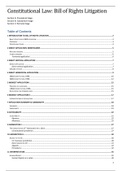Summary
Summary Constitutional Law, Bill of Rights Litigation
- Course
- Constitutional Law 271 (271)
- Institution
- Stellenbosch University (SUN)
Comprehensive summary of all prescribed content for Bill of Rights litigation, namely; class notes & slides, case law and textbook summary. Every prescribed case is discussed in detail and is integrated into the course work. Including tips given by Prof. Slade on what to focus on for the exam.
[Show more]



